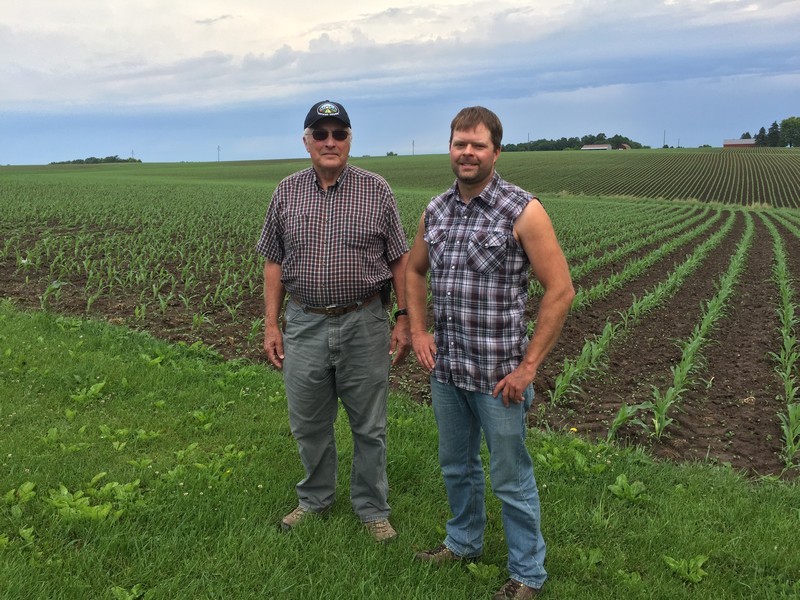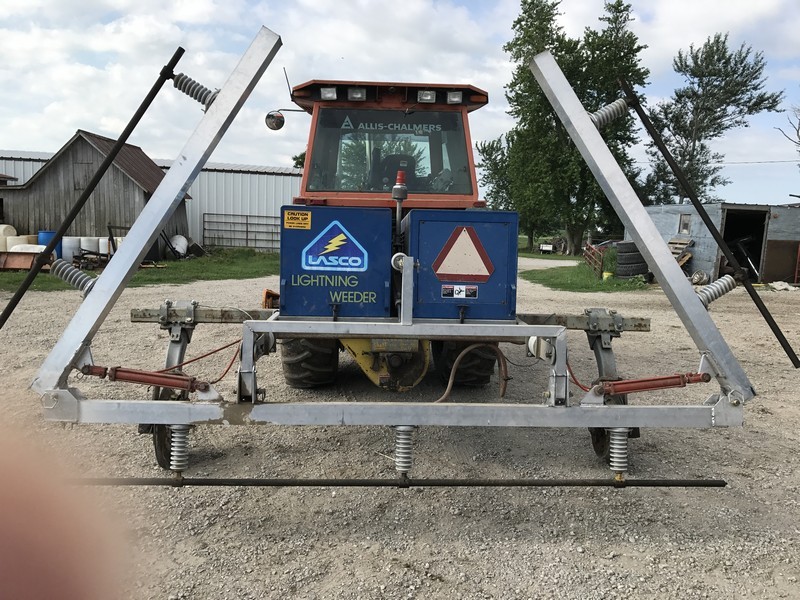Flying W Farm
Wayne & Ryan Wangsness
Wayne and Ryan Wangsness, Flying W Farm
In Pursuit of a Better Bean
The Wangsness family moved to their current farm near Decorah, Iowa when Wayne’s Father bought it in 1943. It has been expanded twice over the years, once when his Father bought a neighboring farm and again when Wayne bought another when he started farming. The farm now stands at 481 tillable organic acres, another 70 acres of managed woodland and another 50 acres of CRP, much of which is managed as pollinator habitat. The farm is now co-managed and co-owned by Wayne’s son Ryan.

Their main crops are corn, oats, and soybeans. They also have 16,000 laying hens. The eggs, and all of the crops, are certified organic.
“Up until the 80s we had a fairly large beef herd, but we hadn’t made any money with them due to low prices, so we knew we needed to make a change. We wanted to get into crops that people wanted, maybe producing a superior product, people would want badly enough to pay a little extra for it. We needed to differentiate,” noted Wayne.
“The big turning point was when I went to a meeting of organic farmers in 1994. It was a group trying to start an organic certification group in Iowa. Duane Bushman and Bill Welsh were two of the organizers. At that time the government wasn’t involved in organic certification. When I left the meeting I was the president of a group that would later become an Iowa chapter of OCIA. By 1995, we were certified and got started with organic soybeans to Japan. The market for organic food-grade soybeans to Japan was great until about 1998-99, when the market collapsed.”
“Soybeans for Japan were a tricky market. Buyers would force you to store beans while they played the market. We had to get away from the abuses of that market. To help do that, we formed the Quality Organic Producers Cooperative in 2000. Some of the founding members were Bill Welsh, Duane Bushman, Merl Steines and myself,” remembered Wayne. “We started with about 30 people expressing an interest in our cooperative, but the number dwindled away as time passed and we worked to get our soy product developed and on the market.”
“We approached Organic Valley almost immediately about producing an organic soy beverage. Organic Valley, we felt, would produce a product that people wanted.”
“It took us until about 2005 to develop a distinctive product. We wanted a better soy product by using the whole bean, which is more healthy because all of the fiber, amino acids, proteins and nutrients are included. With traditional soymilk, the beans are squeezed and the non-liquid parts are discarded. You lose a lot of nutrients and fiber with this process. We worked with World Food Processing, who had a plant in Iowa, to develop this new method of making a soy beverage, and by the fall of 2005, we were ready for the initial production run.”
In the new production process the soybeans are cleaned and ground into a fine powder. The powder was shipped to Devansoy, located in Rock City, Illinois, to be made into soy beverage. They mix the soy powder into water and then process it so that the powder will not settle. After the processing, the beverage is shipped to St. Paul for packaging and flavoring.
“We didn’t know what to expect for sales, so we started small. Sales rose in the first years but have not met our long term expectations. We were unfortunate because, after a time the soymilk market began to shrink, due to allergy concerns and competition from almond milk and others. Initially, a very high percentage of our soybeans went to the soymilk, but as the market shrank so did that percentage. We were balanced until about 2013, now about 50% of our member’s soybeans are used. Sales of soy creamer are selling well, but it is still a small market.”
QOPC soybeans are used to produce three flavors of Organic Valley soy beverages (Original, Vanilla and Chocolate) and two flavors of soy creamer (Original and Vanilla).
“Food grade organic soybeans have always been a difficult product to grow. There is probably a 20% yield drag because feed grade beans are selected for yield and food grade beans for eye appeal. We need better genetics. We are working with World Food Processing to develop a better food grade soybean seed,” emphasized Wayne.
“The other difficulty with growing soybeans is weeds- specifically Giant Ragweed. Some farmers have gotten out of organic because of ragweed,” lamented Wayne.
To combat ragweed, and other problem weeds in soybeans, Wayne and other members of the co-op have developed a combination of strategies.
“In our case, it starts with the rotation. We use alfalfa for at least two years. It greatly diminishes giant ragweed. Then we go into corn, then oats, and then back to hay. We plow up the sod, then plant rye in the fall. We then plow down the rye when it about 8-12” high in the spring. About four days after planting we spike tooth harrow kill weeds and level the surface. We then cultivate as needed. We use a guidance system (optical guidance), which is really nice. We tried a rotary hoe, but decided that a propane flamer was better for killing grass and weakening broadleaves. Working the flamer into our system is still a work in progress”
“Flamers are much better than they used to be. Old units had the intakes at the top of the propane tanks, so the liquid had to vaporize first which caused changes in pressure and uneven results. The newer units have the intake down in the liquid LP which results in more equal pressure and better heat consistency. The University of Nebraska is actively researching and developing better flamers- the improvements are substantial. The problem is that they are expensive,” said Wayne.
Wayne is very excited about the latest development in soybean weed control- the electric weeder. “I think this is a game changer. We can kill any weed that grows above the canopy in soybeans and small grains,” stated Wayne.
Gary Welsh (Lansing, IA) purchased an electric weeder and Wayne and other members of QOPC went to check it out in operation in 2016. “ We saw a machine that could go through a field and kill weeds on contact. Not just the tops, but the whole weed- roots and all. The weeds were dead immediately. The electricity heats the water in the plant and bursts the plant’s cell walls, causing the plant to lose structure and fall over. The unit itself is on a trailer that looks like a sprayer with a 24 foot boom. It requires a 130 hp tractor to drive the PTO which turns a generator which pumps electricity into a capacitor which can release the energy quickly. The boom operates at 15,000 volts. There are two safety devices on the device- if the tractor is not moving, there is no charge in the boom and if there is no driver in the seat, there is no charge. Speed is dependent upon the weed pressure, but we expect to go 2-3 mph through the field.”

QOPC was so impressed that they arranged to lease the machine and rent it to its members and other farmers. “The electric weeder costs $40 per acre to rent, which is about one half the cost of hand weeding. Combined with crop rotation, cultivation and flaming, we have a new tool to combat ragweed and reduce the seedbank.”
To learn more about the electric weeder, and how to rent it, call QOPC at 563-532-9431.
To learn more about recent innovations in propane flaming: http://www.agriculturalflaming.com/

